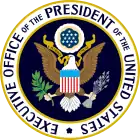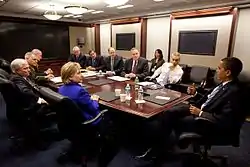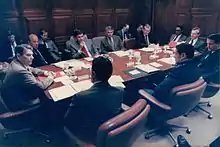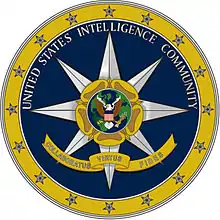United States National Security Council
The White House National Security Council (NSC) is the principal forum used by the President of the United States for consideration of national security, military, and foreign policy matters with senior national security advisors and Cabinet officials and is part of the Executive Office of the President of the United States. Since its inception under Harry S. Truman, the function of the Council has been to advise and assist the President on national security and foreign policies. The Council also serves as the President's principal arm for coordinating these policies among various government agencies. The Council has counterparts in the national security councils of many other nations.
 | |
| Agency overview | |
|---|---|
| Formed | September 18, 1947 |
| Headquarters | Eisenhower Executive Office Building |
| Agency executives |
|
| Parent agency | Executive Office of the President of the United States |
| Website | National Security Council Website |


History
The immediate predecessor to the National Security Council was the National Intelligence Authority (NIA), which was established by President Harry S. Truman's Executive Letter of January 22, 1946, to oversee the Central Intelligence Group, the CIA's predecessor. The NIA was composed of the Secretary of State, the Secretary of War, the Secretary of the Navy, and the Chief of Staff to the Commander in Chief.
The National Security Council was created in 1947 by the National Security Act. It was created because policymakers felt that the diplomacy of the State Department was no longer adequate to contain the Soviet Union, in light of the tension between the Soviet Union and the United States.[1] The intent was to ensure coordination and concurrence among the Army, Marine Corps, Navy, Air Force and other instruments of national security policy such as the Central Intelligence Agency (CIA), also created in the National Security Act. In 2004, the position of Director of National Intelligence (DNI) was created, taking over the responsibilities previously held by the head of CIA, the Director of Central Intelligence, as a cabinet-level position to oversee and coordinate activities of the Intelligence Community.[2]
On May 26, 2009, President Barack Obama merged the White House staff supporting the Homeland Security Council (HSC) and the National Security Council into one National Security Staff (NSS). The HSC and NSC each continue to exist by statute as bodies supporting the President.[3] The name of the staff organization was changed back to National Security Council Staff in 2014.[4]
The #Directorate_of_Global_Health_Security_and_Biodefense was formed in 2016 under the Obama administration, disbanded in 2018 under the Trump Administration, and reinstated in January 2021 during the presidency of Joe Biden.
On January 29, 2017, President Donald Trump restructured the Principals Committee (a subset of the full National Security Council), while at the same time altering the attendance of the Chairman of the Joint Chiefs of Staff and Director of National Intelligence.[5]
According to National Security Presidential Memorandum 2, the Chairman of the Joint Chiefs of Staff and Director of National Intelligence were to sit on the Principals Committee as and when matters pertaining to them arise, but will remain part of the full National Security Council.[6][7] However, Chief of Staff Reince Priebus clarified the next day that they still are invited to attend meetings.[8] With National Security Presidential Memorandum 4 in April 2017, the Director of National Intelligence and the Chairman of the Joint Chiefs of Staff "shall" attend Principals Committee meetings and included the Director of the Central Intelligence Agency as a regular attendee.[9] The reorganization also placed the Administrator of the United States Agency for International Development as a permanent member of the Deputies Committee, winning moderate praise,[10] while the White House Chief Strategist was removed.[11][12]
Authority and powers
The National Security Council was established by the National Security Act of 1947 (PL 235 – 61 Stat. 496; U.S.C. 402), amended by the National Security Act Amendments of 1949 (63 Stat. 579; 50 U.S.C. 401 et seq.). Later in 1949, as part of the Reorganization Plan, the Council was placed in the Executive Office of the President.
The High Value Detainee Interrogation Group also reports to the NSC.[13]
Kill authorizations
A secret National Security Council panel pursues the killing of an individual, including American citizens, who has been called a suspected terrorist.[14] In this case, no public record of this decision or any operation to kill the suspect will be made available.[14] The panel's actions are justified by "two principal legal theories": They "were permitted by Congress when it authorized the use of military forces against militants in the wake of the attacks of September 11, 2001; and they are permitted under international law if a country is defending itself."[14]
Homeland Security Advisor John O. Brennan, who has helped codify targeted killing criteria by creating the Disposition Matrix database, has described the Obama Administration targeted killing policy by stating that "in order to ensure that our counterterrorism operations involving the use of lethal force are legal, ethical, and wise, President Obama has demanded that we hold ourselves to the highest possible standards and processes".[15]
Reuters has reported that Anwar al-Awlaki, an American citizen, was on such a kill list and was killed accordingly.[14]
On February 4, 2013, NBC published a leaked Department of Justice memo providing a summary of the rationale used to justify targeted killing of US citizens who are senior operational leaders of Al-Qa'ida or associated forces.[16]
Membership
The National Security Council, as of 2020 and as per statute[17] and National Security Presidential Memorandum–4, is chaired by the President. Its members are the Vice President (statutory), the Secretary of State (statutory), the Secretary of Defense (statutory), the Secretary of Energy (statutory), the National Security Advisor (non-statutory), the Attorney General (non-statutory), the Secretary of Homeland Security (non-statutory), the Representative of the United States to the United Nations (non-statutory), and the Secretary of the Treasury (statutory).[18][17]
The Chairman of the Joint Chiefs of Staff is the statutory military advisor to the Council, the Director of National Intelligence is the statutory intelligence advisor, and the Director of National Drug Control Policy is the statutory drug control policy advisor. The Chief of Staff to the President, White House Counsel, and the Assistant to the President for Economic Policy are also regularly invited to attend NSC meetings. The Attorney General, the Director of the Office of Management and Budget and The Director of the Central Intelligence Agency are invited to attend meetings pertaining to their responsibilities. The heads of other executive departments and agencies, as well as other senior officials, are invited to attend meetings of the NSC when appropriate.
| Structure of the United States National Security Council[19] | |
|---|---|
| Chairman | President |
| Statutory attendees[20] | Vice President Secretary of State Secretary of Defense Secretary of Energy Secretary of the Treasury |
| Military Advisor (and regular attendee) | Chairman of the Joint Chiefs of Staff[21] |
| Intelligence Advisor (and regular attendee) | Director of National Intelligence[21] |
| Drug Policy Advisor | Director of National Drug Control Policy |
| Regular attendees | National Security Advisor Deputy National Security Advisor Homeland Security Advisor Attorney General White House Chief of Staff |
| Additional participants | Secretary of Homeland Security White House Counsel Director of the Central Intelligence Agency Assistant to the President for Economic Policy Ambassador to the United Nations United States Trade Representative Director of Office of Management and Budget |
Principals Committee
The Principals Committee of the National Security Council is the Cabinet-level senior interagency forum for consideration of national security policy issues. The Principals Committee is convened and chaired by the National Security Advisor. The regular attendees of the Principals Committee are the Secretary of State, the Secretary of the Treasury, the Secretary of Defense, the Attorney General, the Secretary of Energy, the Secretary of Homeland Security, the White House Chief of Staff, the Director of National Intelligence, the Chairman of the Joint Chiefs of Staff, the Director of the Central Intelligence Agency, the Homeland Security Advisor, and the United States Ambassador to the United Nations.[9]
The White House Counsel, the Deputy Counsel to the President for National Security Affairs, the Director of the Office of Management and Budget, the Deputy National Security Advisor, the Deputy National Security Advisor for Strategy, the National Security Advisor to the Vice President, and the NSC Executive Secretary may also attend all meetings of the Principals Committee. When considering international economic issues, the Principals Committee's regular attendees will include the Secretary of Commerce, the United States Trade Representative, and the Assistant to the President for Economic Policy.[22]
Deputies Committee
The National Security Council Deputies Committee is the senior sub-Cabinet interagency forum for consideration of national security policy issues. The Deputies Committee is also responsible for reviewing and monitoring the interagency national security process including for establishing and directing the Policy Coordination Committees.[23] The Deputies Committee is convened and chaired by the Deputy National Security Advisor or the Deputy Homeland Security Advisor.[22]
Regular members of the Deputies Committee are the Deputy National Security Advisor for Strategy, the Deputy Secretary of State, Deputy Secretary of the Treasury, the Deputy Secretary of Defense, the Deputy Attorney General, the Deputy Secretary of Energy, the Deputy Secretary of Homeland Security, the Deputy Director of the Office of Management and Budget, the Deputy Director of National Intelligence, the Vice Chairman of the Joint Chiefs of Staff, the National Security Advisor to the Vice President, the Administrator of the United States Agency for International Development, and the Deputy Director of the Central Intelligence Agency. Invitations to participate in or attend specific meetings are extended to Deputy or Under Secretary level of executive departments and agencies and to other senior officials when relevant issues are discussed. The Executive Secretary and the Deputy White House Counsel also attend. The relevant Senior Director on the National Security Council staff is also invited to attend when relevant.[22]
Policy Coordination Committees
The Policy Coordination Committees of the National Security Council, established and directed by the Deputies Committee, are responsible for the management of the development and implementation of national security policies through interagency coordination. Policy Coordination Committees are the main day-to-day for interagency coordination of national security policy development, implementation and analysis in aide of the Deputies Committee and the Principals Committee. Policy Coordination Committees are chaired by Senior Directors on the National Security Council staff, or sometimes National Economic Council staff, with Assistant Secretary-level officials from the relevant executive department or agency acting as co-chairs.[22]
Directorate of Global Health Security and Biodefense
The Directorate of Global Health Security and Biodefense, created by Barack Obama in 2016 in response to the 2014 Ebola outbreak, was responsible "to prepare for the next disease outbreak and prevent it from becoming an epidemic or pandemic."[24][25] The directorate was disbanded when a May 2018 change in organizational structure by John Bolton, Trump's recently appointed head of the National Security Council, resulted in the effective elimination of the office then led by Rear Admiral Tim Ziemer, Sr. Director for Global Health Security and Biothreats. Remaining staff were moved to other NSC departments, prompting Ziemer's resignation, thus completing the elimination of the office.[26][27][25]
The responsibilities that formerly belonged to the directorate, along with those of arms control and nonproliferation, and of weapons of mass destruction terrorism, were absorbed into a single new directorate, counterproliferation and biodefense, and assigned to Tim Morrison in July 2018 as director. Morrison characterized the consolidation as part of an overall NSC "reduction of force" and called it "specious" to say the office was "dissolved," describing the previous size of the organization as "bloat," and stating "That is why Trump began streamlining the NSC staff in 2017."[28][29] Trump defended the 2018 cuts, describing the financial motivation, when questioned in a February 2020 press conference, suggesting that people on a pandemic response team are unnecessary between pandemics, saying "Some of the people we cut, they haven't been used for many, many years." No source of information could be found to support the president's statement, likely because the team was created in 2016 and disbanded in 2018. He continued: "And rather than spending the money — and I'm a business person — I don't like having thousands of people around when you don't need them."[30] The size of the team before cuts was estimated at 430 people, but the "thousands" referenced by the president also included reduction in the staff numbers of the CDC.[29][31]
In January 2021, the directorate was reinstated by President Joe Biden, who appointed Elizabeth Cameron as Senior Director for Global Health Security and Biodefense, a position she had previously held under the Obama administration and briefly under the Trump administration.[32]
New members
During his presidential transition, President-elect Joe Biden announced the creation of the position of U.S. Special Presidential Envoy for Climate, the occupant of which will be a member of the National Security Council.[33]
See also
- Homeland Security Advisor
- Iran–Contra affair
- National Security Medal
- National Security Advisor
- National Coordinator for Security, Infrastructure Protection and Counter-Terrorism
- Targeted killing
- Title 32 of the Code of Federal Regulations
- Tower Commission
- Trump–Ukraine scandal
- Homeland Security Council
References
- Encyclopedia of American foreign policy, 2nd ed. Vol. 2, New York: Scribner, 2002, National Security Council, 22 April 2009
- Directors of Central Intelligence as Leaders of the US Intelligence Community, Douglas F. Garthoff, 2007, cia.gov
- Helene Cooper (May 26, 2009). "In Security Shuffle, White House Merges Staffs". The New York Times. Retrieved March 15, 2017.
- Caitlin Hayden (February 10, 2014). "NSC Staff, the Name Is Back! So Long, NSS" (Press release). whitehouse.gov. Retrieved March 15, 2017.
- Merrit Kennedy (January 29, 2017). "With National Security Council Shakeup, Steve Bannon Gets A Seat At The Table". NPR. Retrieved January 29, 2017.
- "Presidential Memorandum Organization of the National Security Council and the Homeland Security Council" (Press release). Office of the Press Secretary. January 31, 2017. Retrieved January 31, 2017.
- Jim Garamone (January 31, 2017). "No Change to Chairman's Status as Senior Military Adviser, Officials Say". United States Department of Defense. Retrieved January 31, 2017.
- Alan Yuhas (January 29, 2017). "Trump chief of staff: defense officials not off NSC after Bannon move". The Guardian. Retrieved January 30, 2017.
- Lawfare Blog NSPM-4: "Organization of the National Security Council, the Homeland Security Council, and Subcommittees": A Summary
- Scott Morris (February 7, 2017). "Maybe the Trump Administration Just Elevated Development Policy, or Maybe Not". Center for Global Development. Retrieved March 15, 2017.
- Jennifer Jacobs (April 5, 2017). "Bannon Loses National Security Council Role in Trump Shakeup". Bloomberg. Retrieved April 5, 2017.
- BBC (April 6, 2017). "Steve Bannon loses National Security Council seat". BBC News. Retrieved April 6, 2017.
- Ed Barnes (May 12, 2010). "Elite High Value Interrogation Unit Is Taking Its First Painful Steps". Fox News Channel. Retrieved March 15, 2017.
- Mark Hosenball (October 5, 2011). "Secret panel can put Americans on "kill list"". Reuters. Retrieved March 26, 2017.
- John O. Brennan (April 30, 2012). The Efficacy and Ethics of U.S. Counterterrorism Strategy (Speech). Woodrow Wilson International Center for Scholars. Retrieved March 26, 2017.
- Lawfulness of a Lethal Operation Directed Against a U.S. Citizen Who Is a Senior Operational Leader of Al-Qa'ida or An Associated Force (PDF) (Report). United States Department of Justice. Archived from the original (PDF) on 2014-08-26. Retrieved 2013-02-05.
- "50 U.S. Code § 3021 - National Security Council". LII / Legal Information Institute. Retrieved 2018-01-15.
- "National Security Presidential Memorandum–4 of April 4, 2017" (PDF).
- "Organization of the National Security Council System" (PDF). February 13, 2009.
- "National Security Council". WhiteHouse.gov. Retrieved March 15, 2017.
- Office of the Press Secretary (January 28, 2017). "Organization of the National Security Council and the Homeland Security Council" (PDF) (Press release). White House Office. Retrieved March 15, 2017.
- Federal Register National Security Presidential Memorandum (NSPM-4)
- White House Office of the Press Secretary Presidential Memorandum Organization of the National Security Council and the Homeland Security Council
- Benen, Steve (9 March 2020). "Trump struggles to explain why he disbanded his global health team". MSNBC. Retrieved 14 March 2020.
- Cameron, Beth, "I ran the White House pandemic office. Trump closed it", Washington Post op-ed, March 13, 2020. Retrieved 2020-03-17.
- Weber, Lauren (10 May 2018). "Sudden Departure Of White House Global Health Security Head Has Experts Worried". HuffPost. Retrieved 14 March 2020.
- Sun, Lena H., "Top White House official in charge of pandemic response exits abruptly", Washington Post, May 10, 2018. Retrieved 2020-03-17.
- Morrison, Tim, "No, the White House didn't 'dissolve' its pandemic response office. I was there", Washington Post op-ed, March 16, 2020. Retrieved 2020-03-17.
- Kessler, Glenn and Kelly, Meg. (20 March 2020). "Was the White House office for global pandemics eliminated?". Washington Post website Retrieved 20 March 2020.
- Brady, James (2 February 2020). "Remarks by President Trump, Vice President Pence, and Members of the Coronavirus Task Force in Press Conference". White House, Press Briefings. Retrieved 17 March 2020.
- Palma, Bethania (26 Feb 2020). "Did Trump Administration Fire the US Pandemic Response Team?". Snopes. Retrieved 14 March 2020.
- Crowley, Michael (2021-01-08). "Announcing National Security Council staff appointees, Biden restores the office for global health threats". The New York Times. ISSN 0362-4331. Archived from the original on 2021-01-22. Retrieved 2021-01-23.
- Kate Sullivan. "Biden prioritizes climate crisis by naming John Kerry special envoy". CNN. Retrieved 2020-12-13.
![]() This article incorporates public domain material from websites or documents of the National Archives and Records Administration.
This article incorporates public domain material from websites or documents of the National Archives and Records Administration.
![]() This article incorporates public domain material from websites or documents of the White House.
This article incorporates public domain material from websites or documents of the White House.
![]() This article incorporates public domain material from websites or documents of the United States Department of Justice.
This article incorporates public domain material from websites or documents of the United States Department of Justice.
![]() This article incorporates public domain material from websites or documents of the U.S. Government Publishing Office.
This article incorporates public domain material from websites or documents of the U.S. Government Publishing Office.
![]() This article incorporates public domain material from websites or documents of the Congressional Research Service.
This article incorporates public domain material from websites or documents of the Congressional Research Service.
Further reading
| Library resources about United States National Security Council |
- Bahadir, Sanli. "Arzin Merkezine Seyahat: ABD Ulusal Güvenlik Konseyi" ["Journey to the Center of the World: U.S. National Security Council"]. Article on US NSC (in Turkish).
- Best, Richard A., Jr. "The National Security Council: An Organizational Assessment". (Congressional Research Service, 2009) online.
- Bolton, M. Kent. U.S. National Security and Foreign Policymaking After 9/11: Present at the Re-Creation, Rowman & Littlefield; 2007, ISBN 978-0-7425-4847-3.
- Brown, Cody M. The National Security Council: A Legal History of the President's Most Powerful Advisers, Project on National Security Reform (2008).
- Cutler, Robert. "The Development of the National Security Council". Foreign Affairs 34.3 (1956): 441-458. JSTOR 20031176.
- Daalder, Ivo H. and I. M. Destler, In the Shadow of the Oval Office: Profiles of the National Security Advisers and the Presidents They Served—From JFK to George W. Bush. Simon & Schuster; 2009, ISBN 978-1-4165-5319-9.
- Annual Report to Congress on White House Office Staff; Executive Office of the President, Wednesday, July 1, 2009
- Falk, Stanley L. "The National Security Council Under Truman, Eisenhower, and Kennedy". Political Science Quarterly 79.3 (1964): 403–434. JSTOR 2145907.
- Gans, John. White House Warriors: How the National Security Council Transformed the American Way of War (Liveright, 2019). online review.
- Karl F. Inderfurth and Loch K. Johnson, eds. Fateful Decisions: Inside the National Security Council. Oxford University Press, 2004. ISBN 978-0-19-515966-0.
- Nelson, Anna Kasten. "President Truman and the Evolution of the National Security Council". Journal of American History 72.2 (1985): 360–378. JSTOR 1903380.
- Nelson, Anna Kasten. "The 'top of policy hill': President Eisenhower and the National Security Council". Diplomatic History 7.4 (1983): 307–326. JSTOR 24911374.
- James Peck (2006). Washington's China: The National Security World, the Cold War, and the Origins of Globalism. Amherst, MA: University of Massachusetts Press.
- Rothkopf, David J. (March/April 2005). "Inside the Committee that Runs the World" (Archived copy, including missing image). Foreign Policy.
- David J. Rothkopf, Running The World: the Inside Story of the National Security Council and the Architects of American Power, PublicAffairs; 2006, ISBN 978-1-58648-423-1.
- Sander, Alfred D. "Truman and the National Security Council: 1945–1947". Journal of American History (1972): 369–388. JSTOR online 1890196 online.
- Thorpe, George C. (1917). "[Chapter] V: National Organization of Fighting Forces". Pure Logistics: The Science of War Preparation. Kansas City, Mo.: Franklin Hudson Pub. Co. OCLC 6109722. Advocates for a "National Board of Strategy".
- Whittaker, Alan G., Frederick C. Smith, and Elizabeth McKune. The national security policy process: The national security council and interagency system (Industrial College of the Armed Forces, 2008).
External links
| Wikimedia Commons has media related to National Security Council. |
- Official National Security Council website
- History of the NSC from the White House at the Wayback Machine (archived March 12, 2008)
- Records of the National Security Council (NSC) in the National Archives
- White House Office, National Security Council Staff Papers, 1948–1961, Dwight D. Eisenhower Presidential Library
- Homeland Security Watch (www.HLSwatch.com) provides current details on the NSC as it pertains to homeland security.
- Works by United States National Security Council at Project Gutenberg
- Works by or about United States National Security Council at Internet Archive
